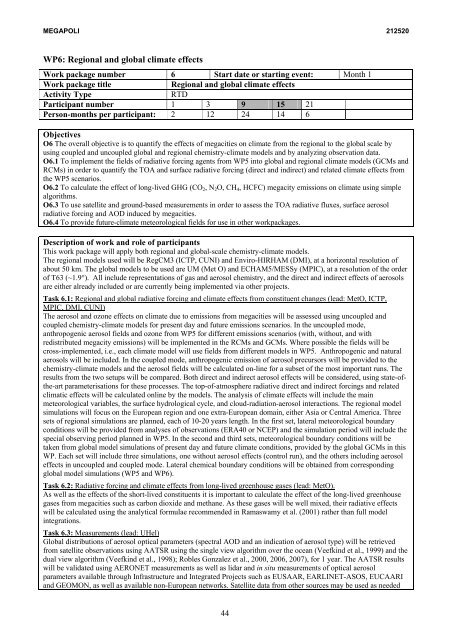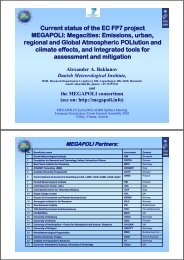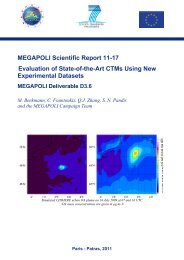D E S C R I P T I O N O F W O R K - MEGAPOLI - Dmi
D E S C R I P T I O N O F W O R K - MEGAPOLI - Dmi
D E S C R I P T I O N O F W O R K - MEGAPOLI - Dmi
Create successful ePaper yourself
Turn your PDF publications into a flip-book with our unique Google optimized e-Paper software.
<strong>MEGAPOLI</strong> 212520<br />
WP6: Regional and global climate effects<br />
Work package number 6 Start date or starting event: Month 1<br />
Work package title Regional and global climate effects<br />
Activity Type RTD<br />
Participant number 1 3 9 15 21<br />
Person-months per participant: 2 12 24 14 6<br />
Objectives<br />
O6 The overall objective is to quantify the effects of megacities on climate from the regional to the global scale by<br />
using coupled and uncoupled global and regional chemistry-climate models and by analyzing observation data.<br />
O6.1 To implement the fields of radiative forcing agents from WP5 into global and regional climate models (GCMs and<br />
RCMs) in order to quantify the TOA and surface radiative forcing (direct and indirect) and related climate effects from<br />
the WP5 scenarios.<br />
O6.2 To calculate the effect of long-lived GHG (CO2, N2O, CH4, HCFC) megacity emissions on climate using simple<br />
algorithms.<br />
O6.3 To use satellite and ground-based measurements in order to assess the TOA radiative fluxes, surface aerosol<br />
radiative forcing and AOD induced by megacities.<br />
O6.4 To provide future-climate meteorological fields for use in other workpackages.<br />
Description of work and role of participants<br />
This work package will apply both regional and global-scale chemistry-climate models.<br />
The regional models used will be RegCM3 (ICTP, CUNI) and Enviro-HIRHAM (DMI), at a horizontal resolution of<br />
about 50 km. The global models to be used are UM (Met O) and ECHAM5/MESSy (MPIC), at a resolution of the order<br />
of T63 (~1.9°). All include representations of gas and aerosol chemistry, and the direct and indirect effects of aerosols<br />
are either already included or are currently being implemented via other projects.<br />
Task 6.1: Regional and global radiative forcing and climate effects from constituent changes (lead: MetO, ICTP,<br />
MPIC, DMI, CUNI)<br />
The aerosol and ozone effects on climate due to emissions from megacities will be assessed using uncoupled and<br />
coupled chemistry-climate models for present day and future emissions scenarios. In the uncoupled mode,<br />
anthropogenic aerosol fields and ozone from WP5 for different emissions scenarios (with, without, and with<br />
redistributed megacity emissions) will be implemented in the RCMs and GCMs. Where possible the fields will be<br />
cross-implemented, i.e., each climate model will use fields from different models in WP5. Anthropogenic and natural<br />
aerosols will be included. In the coupled mode, anthropogenic emission of aerosol precursors will be provided to the<br />
chemistry-climate models and the aerosol fields will be calculated on-line for a subset of the most important runs. The<br />
results from the two setups will be compared. Both direct and indirect aerosol effects will be considered, using state-ofthe-art<br />
parameterisations for these processes. The top-of-atmosphere radiative direct and indirect forcings and related<br />
climatic effects will be calculated online by the models. The analysis of climate effects will include the main<br />
meteorological variables, the surface hydrological cycle, and cloud-radiation-aerosol interactions. The regional model<br />
simulations will focus on the European region and one extra-European domain, either Asia or Central America. Three<br />
sets of regional simulations are planned, each of 10-20 years length. In the first set, lateral meteorological boundary<br />
conditions will be provided from analyses of observations (ERA40 or NCEP) and the simulation period will include the<br />
special observing period planned in WP5. In the second and third sets, meteorological boundary conditions will be<br />
taken from global model simulations of present day and future climate conditions, provided by the global GCMs in this<br />
WP. Each set will include three simulations, one without aerosol effects (control run), and the others including aerosol<br />
effects in uncoupled and coupled mode. Lateral chemical boundary conditions will be obtained from corresponding<br />
global model simulations (WP5 and WP6).<br />
Task 6.2: Radiative forcing and climate effects from long-lived greenhouse gases (lead: MetO).<br />
As well as the effects of the short-lived constituents it is important to calculate the effect of the long-lived greenhouse<br />
gases from megacities such as carbon dioxide and methane. As these gases will be well mixed, their radiative effects<br />
will be calculated using the analytical formulae recommended in Ramaswamy et al. (2001) rather than full model<br />
integrations.<br />
Task 6.3: Measurements (lead: UHel)<br />
Global distributions of aerosol optical parameters (spectral AOD and an indication of aerosol type) will be retrieved<br />
from satellite observations using AATSR using the single view algorithm over the ocean (Veefkind et al., 1999) and the<br />
dual view algorithm (Veefkind et al., 1998); Robles Gonzalez et al., 2000, 2006, 2007), for 1 year. The AATSR results<br />
will be validated using AERONET measurements as well as lidar and in situ measurements of optical aerosol<br />
parameters available through Infrastructure and Integrated Projects such as EUSAAR, EARLINET-ASOS, EUCAARI<br />
and GEOMON, as well as available non-European networks. Satellite data from other sources may be used as needed<br />
44




